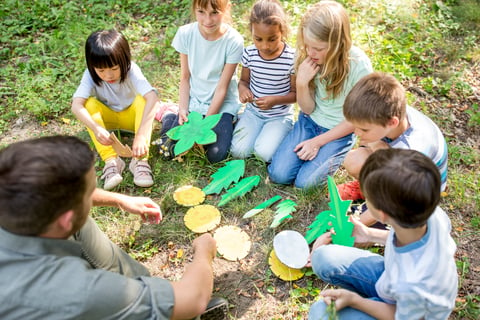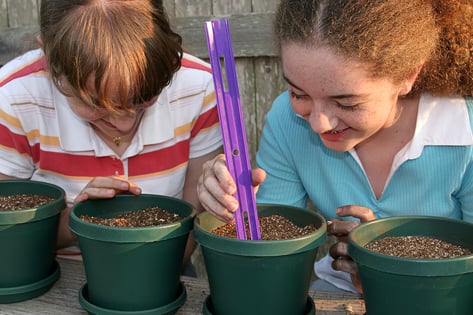ALI Staff | Published August 15, 2023
You might think STEM is all about experiments in the classroom or working with computers. But it's not just for the indoors!
STEM can be taken outside, and there are lots of outdoor or nature projects that are not as hard as you think. In fact, they can be pretty easy!
Taking STEM out of the classroom and into the outside world makes learning even more real and definitely more fun.
Being in a new environment makes learning exciting for students, ignites their curiosity, and creates memorable learning experiences.
Outdoor STEM activities and projects help students connect what they learn in the classroom to the real world.
It's also a nice change for teachers, who can show new and different things. The best part?
Outdoor STEM is not something hard or scary. It's a way to learn that fits right in with everything else you are teaching.
Various research studies have found that outdoor play, whether structured or unstructured, offers benefits to a child’s emotional state, attention span, physical fitness, imagination, and more.
Given these general benefits, it’s a natural next step for teachers to consider creating playful outdoor STEM activities that teach kids the elements of science, technology, education, and even math while satisfying their natural inquisitiveness about the world around them.
Keep reading for tips on how to make outdoor STEM work for you and your students, as well as examples of easy STEM projects and activities that you can implement in your classroom.

With some thoughtful, intentional planning, outdoor STEM projects and experiments can increase students’ understanding of science on multiple levels. Here are some general tips about using the outdoors for science experiments and STEM activities for kids.

Playtime outdoors is a great time to introduce science concepts and procedures to students and learners of all ages, but especially preschoolers and kindergartners.
Outdoor STEM activities and STEM projects done in nature can ignite the natural curiosity these young learners have about the world around them.
Natural questions students of this age ask, like “Why is the sky blue?” and “Why do some things float while other things don’t?” can easily be turned into engaging science activities outside.
Discovering science concepts through hands-on explorations in nature not only deepens a student's ability to see how science is connected to the real world but also shows how easily outdoor STEM activities can be integrated into their learning experience from a very early age.
Discovering how science is connected to the real world, which STEM is all about, is easily accomplished through hands-on activities and projects outdoors.
Further, engaging young students in intentional discourse invites them to think like scientists.
Teachers can ask open-ended questions like “What did you notice?” or “Why do you think that is?” and start learners on a path to problem-solving that will benefit them throughout their academic careers and beyond.
Many activities for students at this age can be simply structured around sharpening their observation skills and their ability to describe differences in what they notice.
For example, you may focus on the differences between sand, pebbles, garden soil, mulch, and mud.
Or you might gather differently shaped leaves and talk about the different ways to describe them and why they might have evolved to be different.
On a cloudy or windy day, you might ask the students to observe and draw different cloud shapes or find ways to measure and describe how strong the wind is (tying a ribbon to a post, letting a leaf go, and watching to see how far it is taken, improvising a sail, etc.).
Or, simply use the space outdoors for a modified number-matching game, where the learners match numerals with groups of objects you have set up in advance.

If you have access to a park or outdoor area, this is an easy and engaging nature STEM (or STEAM) activity.
Simply take learners on a walk, stopping at different locations and asking them to use their five senses to observe and describe what they experience in nature.
If feasible, bring art supplies and use the stops as a chance for students to draw some of the things they observe.
Suggest that they consider animals, plants, soil, clouds, terrain, water, and other aspects of the natural world.
Though not necessarily an outdoor activity, this cool STEM project is nature-themed and allows students to practice the scientific method.
In this science activity, water vapor condenses into water droplets that attach to particles in the air within a Mason jar, creating a visible cloud.
For younger grades, this STEM activity can be paired with reading about weather and then observing, describing, and drawing clouds of different types outside.
Older students can perform the experiment themselves and try two alternate variations as part of a unit on the water cycle and observing and recording weather patterns over time.
Starting inside with a lesson on leaf parts and then venturing outdoors to identify leaf shapes, this nature STEM activity encourages students to explore and understand the variety of shapes in the environment.
Younger learners may not necessarily learn the specialized vocabulary describing different leaf shapes, although they may surprise you with their ability to memorize the names (similar to their ability to memorize different dinosaur names!).
Then take a walk outside to find vines, shrubs, trees, and other plants, and identify their leaf shapes.
Older students might take photographs or sketches and create a poster demonstrating their labeled finds.
Younger learners might start with an art project where they create a set of paper leaf shapes on popsicle sticks that they can use to compare to leaves they find outdoors.
This could be a multi-day STEM project, starting with a discussion about soil structure (what soil is made of), what lives in soil, how much water is the right amount (of course, the answer depends on what lives in it), and how to measure the amount of moisture in the soil.
Students experiment with soil moisture and how this affects what grows in it, making it a hands-on outdoor STEM activity that ties science to the real world.
Explore the sun's effects through this outdoor STEM activity designed for lower elementary grades.
This nature STEM activity invites learners to observe the different effects of sun and shade on different natural and man-made materials and ground covers.
Additional activities that dig deeper include exposing paper cups filled with different types and colors of soil, water, and pebbles to sunlight, and observing or measuring how much heat they absorb.
As a complement to a unit or scope on how and why plants disperse their seeds, this outdoor activity can be done outside on a windy day or inside using a table fan.
Students create different types of “seeds” using paper, paper clips, and other art supplies, then observe how well they travel when released into the wind.
This project could be set up as a competition, as a controlled experiment, or even as a STEAM-style activity.
And after you’ve talked about the forces of the wind, you might want to pick a windy day to go fly kites!
And while we’re working with wind – elementary-age students can create their own anemometers using paper cups, straws, and a pencil.
This elementary STEM project can start inside as a controlled experiment with a fan that runs at different speeds and then move outside on different days and/or in different locations.
Students can also be challenged to convert the speed of their anemometers to miles per hour using their math and geometry skills.
This cool STEM project involves creating a weather station over several outdoor sessions.
Starting with some foundational study of weather patterns, it can even be expanded into a semester-long project for older elementary students.
Students build four simple tools to collect data on wind speed, air pressure, temperature, and precipitation, then make their own weather predictions based on the science of weather.
A hands-on outdoor STEM activity that builds teamwork; this one is always a fan favorite.
Group your students into small teams and challenge them to build the largest tower they can using only string and sticks of different sizes.
In addition to being an engineering challenge, this activity gives them practice with math skills since they must “purchase” their materials using points, and they must measure their final tower and calculate the points they gain from each centimeter of height.
Your ability to lead these activities may depend on your access to the outside world.
However, you don’t need to take your class to a national park to observe the clouds or measure air temperature: whether you’re in an area of outstanding natural beauty or an urban school playground – you are still surrounded by the natural world, and there will be things to pique the students’ curiosity and satisfy their inquisitiveness.
Children love any opportunity to explore nature.
So, go out and explore!

At the start of the school year, teachers have the chance to create a math classroom where every student feels valued...

Math manipulatives are a great way to make math more accessible for your students, especially if you know they may...

Storytelling is one of the oldest forms of communication as a way to share experiences, understand others, and...